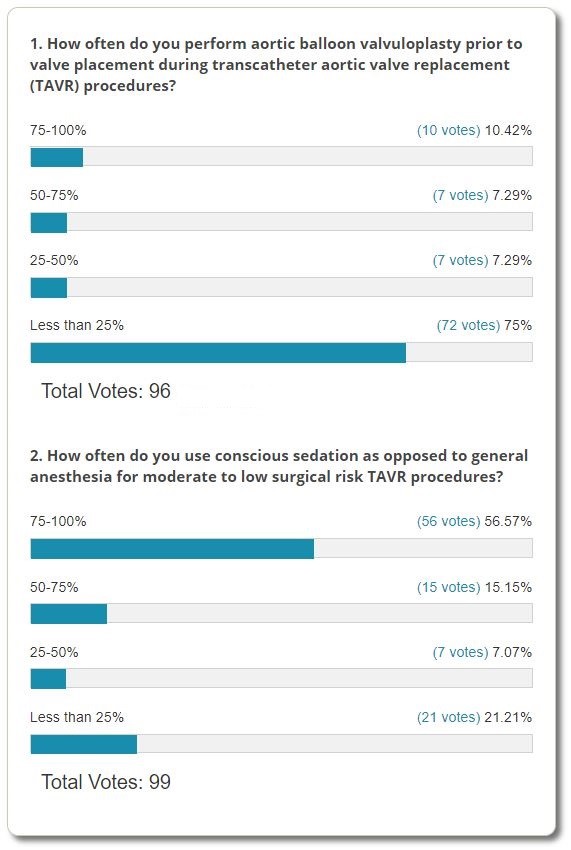Poll Results: Selected Current TAVR Techniques
Quick Takes
- Pre-dilatation with balloon valvuloplasty before transcatheter aortic valve replacement (TAVR) and TAVR without pre-dilatation yield similar results based on the PARTNER 3 (Placement of Aortic Transcatheter Valves 3) trial.
- Procedure time was reduced in patients undergoing TAVR without balloon valvuloplasty.
- Conscious sedation compared to general anesthesia in the PARTNER 2 trial (SAPIEN 3 ([Edwards Lifesciences; Irvine, CA]) of intermediate- and low-risk patients lead to shorter procedure times and shorter intensive care unit and hospital stays as well as less cost without differences in outcome up to 1 year.
The recent poll assessed practice preferences by our respondents, comparing their responses to recent analyses of practice patterns.
When performing TAVR, most of our respondents do not perform balloon valvuloplasty pre-dilatation in most cases, with 75% performing balloon valvuloplasty before TAVR less than a quarter of the time. Based on a report from the PARTNER 3 trial,1 not performing pre-dilatation is associated with shorter procedure time with no difference in outcome and no need for more post-placement dilatation. This is interesting and consistent with the frequency of pre-dilatation reflected in the poll. Additionally, an accompanying editorial2 noted that there are certain circumstances in which pre-dilatation may be helpful. Thus, depending on patient types and procedure comfort, the poll responses overall likely reflect current practice.
Regarding the question about use of conscious sedation as opposed to the initial universal use of general anesthesia, over half of respondents (57%) use conscious sedation most (75-100%) of the time. Consistent with more frequent use of conscious sedation, Hermann et al.3 demonstrated that in moderate- and low-risk patients from the PARTNER 2 trial using the SAPIEN 3 valve, conscious sedation resulted in similar outcomes to 1 year with shorter procedure, intensive care unit, and hospital time compared to general anesthesia.
Thanks to all who participated and showed that practice is reflecting current trial results.

References
- Ternacle J, Al-Azizi K, Szerlip M, et al. Impact of Predilation During Transcatheter Aortic Valve Replacement: Insights From the PARTNER 3 Trial. Circ Cardiovasc Interv 2021;14:e010336.
- DeRose JJ, Chau M. Predilation in Transcatheter Aortic Valve Replacement: A Technique Whose Time Has Passed or an Important Skill to Keep in the Toolbox? Circ Cardiovasc Interv 2021;14:e011016.
- Herrmann HC, Cohen DJ, Hahn RT, et al. Utilization, Costs, and Outcomes of Conscious Sedation Versus General Anesthesia for Transcatheter Aortic Valve Replacement. Circ Cardiovasc Interv 2021;14:e010310.
Clinical Topics: Cardiac Surgery, Invasive Cardiovascular Angiography and Intervention, Interventions and Vascular Medicine
Keywords: Balloon Valvuloplasty, Conscious Sedation, Transcatheter Aortic Valve Replacement, Dilatation, Anesthesia, General, Aneurysm, Catheters, Intensive Care Units, Hospitals
< Back to Listings
